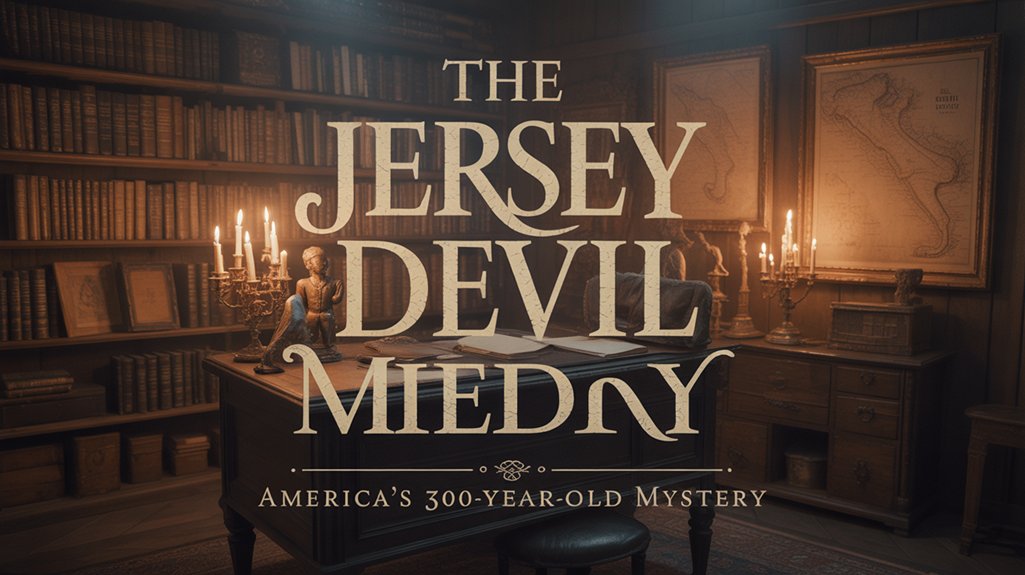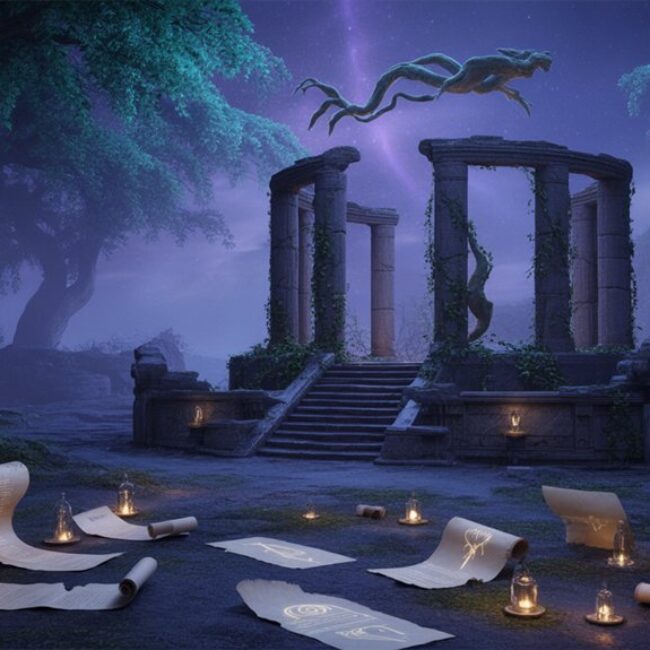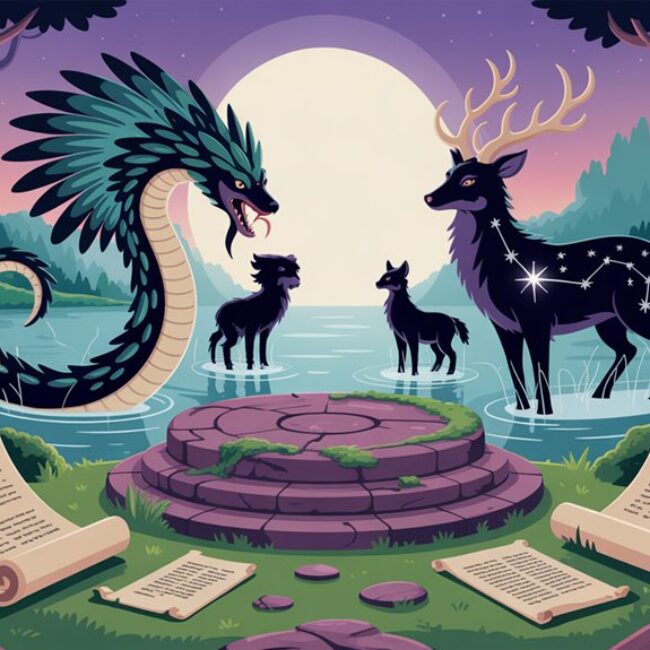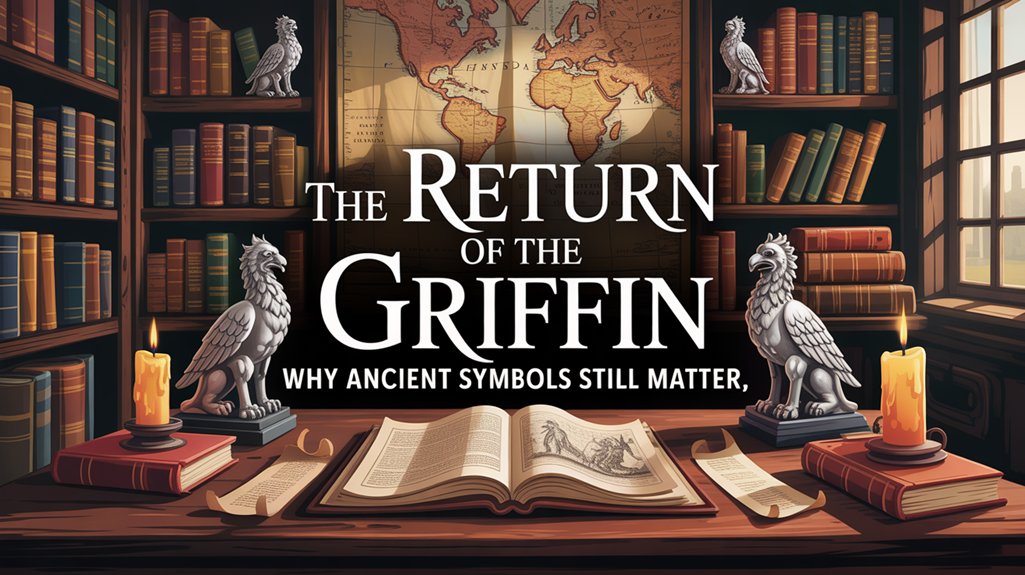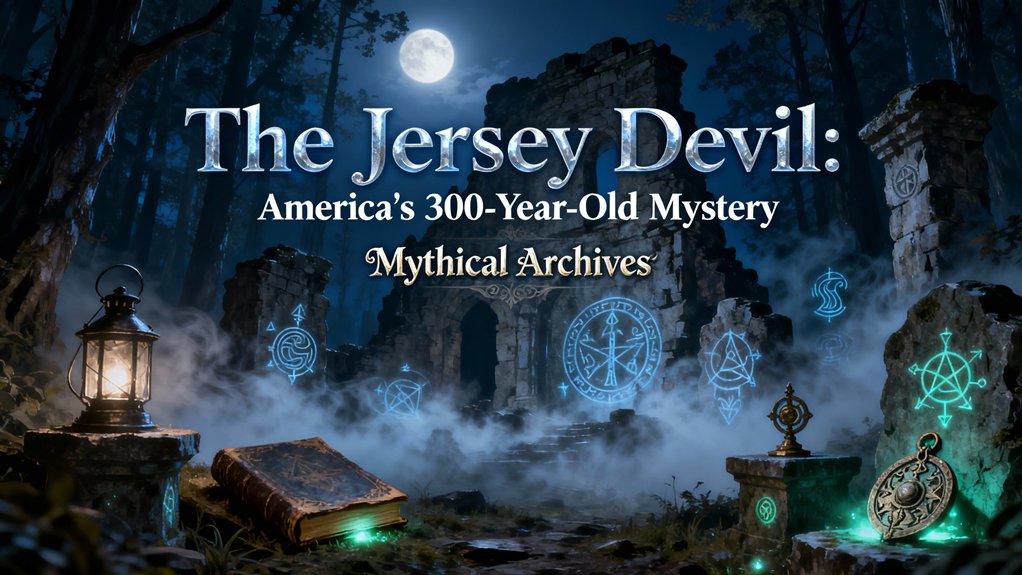
You’ll discover America’s most enduring cryptid emerged in 1735 when Mother Leeds’ cursed thirteenth child changed into a chimeric horror—possessing leathery bat wings, cloven hooves, and a serpentine tail—before vanishing into New Jersey’s Pine Barrens. The creature’s 1909 Week of Terror paralyzed entire municipalities with factory closures and armed posses, while contemporary investigators employ thermal imaging near ancient waterways where witnesses still report elongated forms moving through fog-laden marshlands. The truth inhabits that liminal space between dismissive rationalism and the consistent testimony spanning three centuries, beckoning further exploration.
Table of Contents
ToggleKey Takeaways
- The Jersey Devil originated in 1735 when Mother Leeds’ cursed thirteenth child transformed into a winged, hooved creature.
- January 1909 brought mass hysteria with widespread sightings causing factory closures, school shutdowns, and armed community patrols.
- Witnesses consistently describe a chimeric entity with bat wings, horse-like skull, cloven hooves, and glowing red eyes.
- The legend blends documented historical events with folklore, challenging explanations ranging from misidentified wildlife to interdimensional phenomena.
- The creature remains culturally significant through festivals, sports branding, and ongoing investigations using modern technology like thermal imaging.
The Cursed Birth of Mother Leeds’ Thirteenth Child
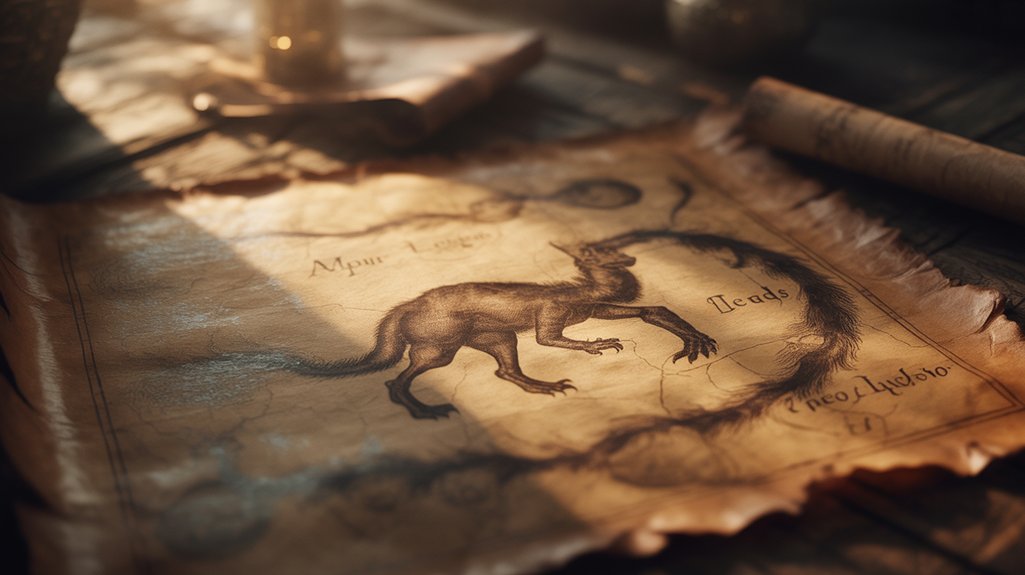
When Mother Leeds discovered her thirteenth pregnancy in 1735, the impoverished woman—already overwhelmed by the burden of a dozen children in the unforgiving Pine Barrens of colonial New Jersey—reportedly cursed the unborn child in a moment of desperate anguish.
You’ll find this cursed lineage woven throughout supernatural folklore, a record of colonial desperation manifesting as eldritch alteration.
The birth itself defied nature. Witnesses described a normal infant rapidly changing into something chimeric: leathery wings erupted from shoulders, hooves replaced human feet, a forked tail lashed violently.
The creature shrieked with voices not of this world before ascending the chimney, vanishing into January’s frozen darkness.
This wasn’t mere superstition. Multiple accounts document the event, establishing provenance for America’s most enduring cryptid legend.
The Leeds family’s actual existence—documented in colonial records—grounds the mythology in verifiable history, creating that liminal space where documented fact dissolves into shadow.
The cursed thirteenth child became something beyond human comprehension, forever prowling the Pine Barrens’ ancient pathways.
The Infamous 1909 Week of Terror
You must understand that January 1909 altered the Jersey Devil from whispered folklore into visceral, documented terror—a week when the chimeric entity materialized across dozens of municipalities, witnessed by thousands who could no longer dismiss the creature as superstition.
From Bristol, Pennsylvania, to Camden, New Jersey, citizens encountered the same eldritch beast: leathery wings spanning six feet, cloven hooves that left inexplicable tracks in fresh snow, a serpentine tail, and eyes that burned phosphorescent green in the winter darkness.
The mass hysteria that gripped the Delaware Valley wasn’t mere panic; it was collective confrontation with something that shattered the boundaries between rational modernity and ancient, unknowable darkness.
Mass Sightings Across Towns
How does a centuries-old legend evolve into mass hysteria that grips an entire region in the span of seven days?
January 1909 witnessed something unprecedented: the chimeric entity emerged from Pine Barrens obscurity into populated consciousness, terrorizing communities across New Jersey and Pennsylvania.
Citizens reported encounters simultaneously across multiple municipalities:
- Bristol, Pennsylvania – Residents discovered cloven hoofprints traversing rooftops, defying natural locomotion.
- Camden – Trolley passengers witnessed the eldritch creature attacking their conveyance at midnight.
- Gloucester City – Factory workers refused night shifts after sighting the beast circling industrial complexes.
- Trenton – Police officers fired upon the apparition, bullets passing through its form.
- Philadelphia – Theaters and schools closed as community folklore evolved into paralyzing fear.
This wasn’t isolated testimony.
Mass hysteria consumed the region, validating what generations had whispered.
Eyewitness Accounts and Descriptions
Testimonies converged with disturbing consistency across socioeconomic boundaries, eliminating dismissal as mere peasant superstition or uneducated folklore.
Factory foremen, postal workers, police officers—all documented the chimeric entity with remarkable precision. You’ll find eyewitness reliability strengthened through independent corroboration: leathery wings spanning twelve feet, cloven hooves leaving tracks in virgin snow, that eldritch screech piercing January darkness.
Description variations emerged in subtle particulars—some witnesses reported phosphorescent eyes, others coal-black voids—yet core anatomical features remained constant. A Bristol trolley operator, trembling, described the creature’s serpentine tail. Gloucester’s harbormaster watched it glide above frozen marshlands.
These weren’t hysteric fantasies. These were measured observations from citizens who’d never met, separated by miles, unified by terror. Something ancient prowled the Pine Barrens that week.
Community Panic and Response
When hysteria ignited across southern New Jersey during that glacial January of 1909, municipal authorities confronted something beyond their administrative vocabulary—a collective psychosis rooted in tangible evidence.
Community fears crystallized into unprecedented action as local legends manifested in hoofprints across snow-laden rooftops, eldritch screams piercing industrial smokestacks.
Municipal responses included:
- Factory closures throughout Bristol and Camden
- Armed posses patrolling with lanterns and rifles
- Schools shuttered for three consecutive days
- Trolley operations suspended after dusk
- Reward offerings totaling substantial sums
You must understand—this wasn’t mere superstition.
Farmers discovered mutilated livestock. Mill workers witnessed chimeric silhouettes against frozen Delaware waters. The boundary between folklore and phenomenon dissolved completely.
Authority structures, designed for rational governance, buckled beneath something primordial, something that refused categorization within their empirical frameworks.
Physical Descriptions and Reported Characteristics
Across three centuries of documented encounters, witnesses have described the Jersey Devil with remarkable consistency, their testimonies coalescing into a portrait of something fundamentally chimeric—a creature that defies natural taxonomy.
You’ll find accounts detailing physical traits that merge mammalian, reptilian, and avian elements: a horse-like skull elongated into something predatory, leathery bat wings spanning twelve feet, cloven hooves that leave tracks in frozen ground. The mythical features reported most frequently include glowing red eyes that pierce darkness, a forked tail capable of striking like a whip, and hindquarters resembling a kangaroo’s muscular form.
The creature’s vocalization—described as piercing, unholy screaming—accompanies sightings with disturbing regularity. Standing between six and eight feet tall when upright, it moves with unnatural fluidity between bipedal and quadrupedal gaits.
This eldritch amalgamation embodies something ancient, something that shouldn’t exist yet persists in eyewitness testimony spanning 1735 to present day.
Notable Encounters and Eyewitness Accounts Through the Centuries

The documented record crystallizes in 1778 with Commodore Stephen Decatur’s encounter at the Hanover Iron Works, where the naval hero—a man trained in precise observation—discharged cannon fire at a winged entity circling the munitions foundry.
This testimony carries weight. You’re examining historical folklore transmitted through generations, accounts preserved despite their eldritch nature challenging rational frameworks.
Key Documented Encounters:
- Joseph Bonaparte (1820) spotted the chimeric creature while hunting near Bordentown, the former King of Spain’s credibility lending cultural significance to Pine Barrens legends.
- 1840s railroad workers repeatedly delayed construction, refusing to labor where the beast manifested at dusk.
- January 1909—the watershed week when thousands across Philadelphia, Camden, and Trenton reported synchronized sightings.
- Postmaster E.W. Minster discovered unidentifiable tracks in fresh snow, definitively non-hoofed, defying taxonomic classification.
- Gloucester City residents watched it consume a dog before ascending into darkness.
Each witness surrendered skepticism.
You’re confronting accumulated testimony spanning centuries, altering folklore into documented phenomenon.
Scientific Explanations and Skeptical Theories
Rationalist frameworks have systematically attempted to dismantle the Jersey Devil phenomenon since the early twentieth century, yet each explanation reveals fissures when confronted with the accumulated weight of testimony.
You’ll encounter scientific skepticism attributing sightings to misidentified sandhill cranes, their prehistoric silhouettes casting eldritch shadows across moonlit marshlands. Some researchers propose barn owls, their faces ghostly white, their shrieks penetrating midnight’s veil.
Between rational explanation and witnessed terror lies the sandhill crane—prehistoric, misunderstood, casting shadows that refuse simple categorization.
Others invoke mass hysteria—particularly during January 1909’s concentrated sightings—dismissing centuries of Indigenous warnings and colonial-era encounters as collective delusion.
But examine the specificity. Witness descriptions remain remarkably consistent: bifurcated hooves, leathery wings spanning twelve feet, that serpentine tail.
Consider how paranormal explanations honor this chimeric persistence, suggesting interdimensional manifestations or thoughtforms sustained by regional consciousness. The Lenape spoke of such beings long before Leeds cursed his thirteenth child in 1735.
Your freedom demands questioning both camps. Truth dwells between dismissive rationalism and uncritical belief—in that liminal space where ancient knowledge meets empirical inquiry.
The Jersey Devil’s Impact on Local Culture and Tourism

Beyond mere folklore, the Jersey Devil functions as economic lifeblood and cultural anchor throughout the Pine Barrens, altering centuries of dread into tangible heritage.
You’ll discover how this eldritch entity has changed regional identity, channeling chimeric terror into profitable enterprise. Local folklore weaves through every commercial venture, each restaurant menu, each guided tour—ancient narratives repackaged for contemporary consumption while maintaining their mystical potency.
The creature’s economic manifestation includes:
- Annual festivals celebrating cryptid mythology, drawing thousands to remote Pine Barrens townships
- Brewery partnerships featuring devil-themed craft beverages, changing taverns into pilgrimage sites
- Hockey team branding legitimizing the legend through professional sports iconography
- Heritage trail systems guiding seekers through documented sighting locations
- Artisan cooperatives producing handcrafted memorabilia embedded with regional mystique
This tourism boost sustains communities that might otherwise fade into economic obscurity.
The devil’s persistent haunting becomes salvation—proof that darkness, properly channeled, illuminates prosperity.
Modern Sightings and Ongoing Investigations
While commercial exploitation alters legend into merchandise, contemporary encounters persist with unsettling frequency—documented through cellular footage, thermal imaging, and eyewitness testimony that refuses comfortable dismissal.
You’ll find recent encounters clustered near the Pine Barrens’ ancient waterways, where witnesses describe elongated chimeric forms moving through fog-laden marshlands with predatory grace.
Investigation techniques have evolved beyond folklore collection: cryptozoologists now deploy motion-activated cameras, analyze claw marks against known species databases, and document electromagnetic anomalies correlating with sighting patterns.
These methodical approaches yield disturbing consistencies. The creature’s eldritch silhouette appears repeatedly across decades—bifurcated hooves, leathery wings, serpentine tail—defying easy categorization.
You can’t ignore the 2015 thermal capture from Galloway Township, showing heat signatures inconsistent with regional fauna. Nor the 2019 Delaware River footage.
These fragments accumulate, suggesting something genuinely liminal persists in those shadowed woodlands, existing beyond our taxonomic certainties, demanding recognition you’re increasingly compelled to grant.
Frequently Asked Questions
Has Anyone Ever Captured Photographic or Video Evidence of the Jersey Devil?
You’ll find no authenticated photographic evidence of this eldritch creature, despite centuries of pursuit.
Video sightings remain equally elusive, chimeric shadows that dissolve under scrutiny. Blurred images surface periodically—grainy, inconclusive fragments that tantalize rather than confirm.
The Pine Barrens entity guards its mysteries jealously, existing in those liminal spaces where concrete documentation fails.
Perhaps this absence itself speaks truth: some phenomena resist capture, dwelling forever between witnessed experience and empirical proof, honoring ancient patterns of unknowing.
What Is the Best Location to Visit if Hoping to Spot the Creature?
You’ll find your answer deep within New Jersey’s Pine Barrens, where twisted cedar and pitch pine create an eldritch cathedral of shadows.
The Leeds Point area, birthplace of this chimeric entity in 1735, remains the epicenter of encounters.
Venture into the aptly named Devil’s Playground near Chatsworth, where sandy trails wind through dense undergrowth and ancient bog iron pits.
Here, in these liminal spaces between civilization and wilderness, you’re most likely to glimpse the creature’s phosphorescent eyes piercing the darkness.
Are There Any Organized Jersey Devil Tours or Hunting Expeditions Available?
You’ll find several Jersey Devil tours operating through the Pine Barrens, particularly near Leeds Point where the chimeric entity first manifested in 1735.
Local guides offer nighttime Jersey Devil expeditions, leading seekers through ancient cedar swamps and forgotten colonial trails. These excursions blend historical documentation with folklore investigation—you’re free to interpret the shadows yourself.
Some paranormal research groups welcome independent hunters during their investigations. The eldritch wilderness remains accessible; no authority restricts your nocturnal pursuits of this enduring cryptid.
Has the Jersey Devil Ever Been Blamed for Any Human Deaths or Disappearances?
You’ll find no documented fatalities attributed to this eldritch entity—remarkably, across three centuries of Jersey Devil folklore, zero deaths bear official record.
Historical accounts consistently describe frightening encounters, property destruction, livestock mutilations, yet human casualties remain conspicuously absent.
This chimeric creature inspires terror through presence alone, respecting boundaries between mortal and supernatural domains.
You’re witnessing folklore’s restraint: a beast powerful enough to kill, choosing instead to haunt, warn, and vanish into pine barrens’ shadows, preserving its enigmatic liberty.
What Should Someone Do if They Encounter the Jersey Devil in Person?
Should you encounter this chimeric entity, remain calm—panic invites vulnerability.
Local legends counsel against direct eye contact with eldritch beings; instead, back away slowly while maintaining awareness of your surroundings.
Safety precautions passed through generations emphasize respect rather than confrontation: speak no provocations, carry iron or salt as traditional wards, and seek shelter in consecrated spaces.
The creature reportedly fears fire, church bells, and dawn’s approach.
Document your experience afterward; you’re now part of living folklore, a witness to America’s enduring mystery.
Conclusion
You’ve traced the chimeric entity through three centuries of testimony, weighed skeptical rationale against inexplicable encounters, examined the eldritch persistence of Leeds’ cursed lineage. Yet the Pine Barrens remain. Dark. Waiting. Perhaps you’ll venture there yourself, where moonlight filters through ancient cedars and something moves between the trees—neither wholly beast nor phantom. Will you dismiss centuries of witnesses? Or will you finally understand why some mysteries resist explanation? The choice, inevitably, becomes yours.

